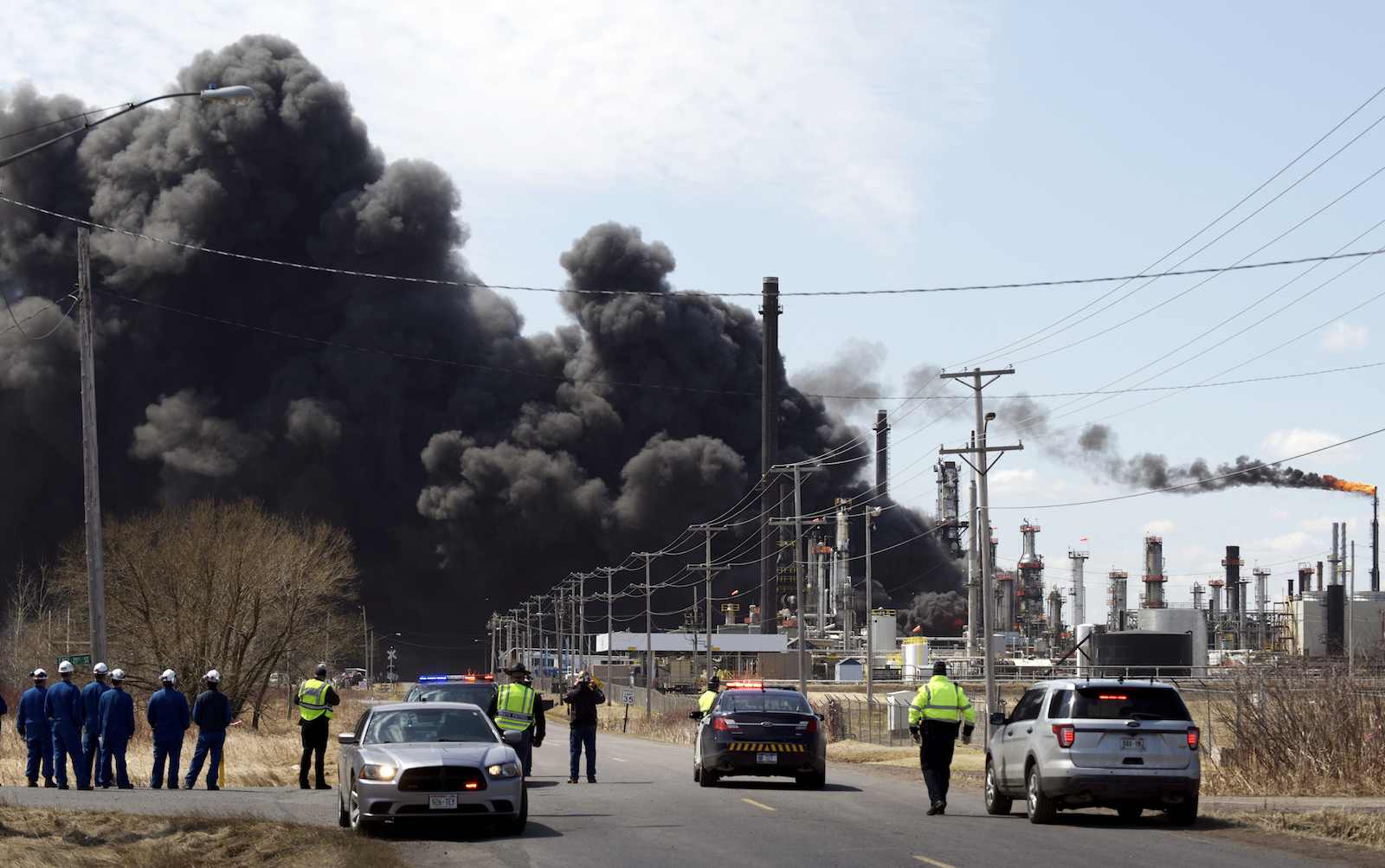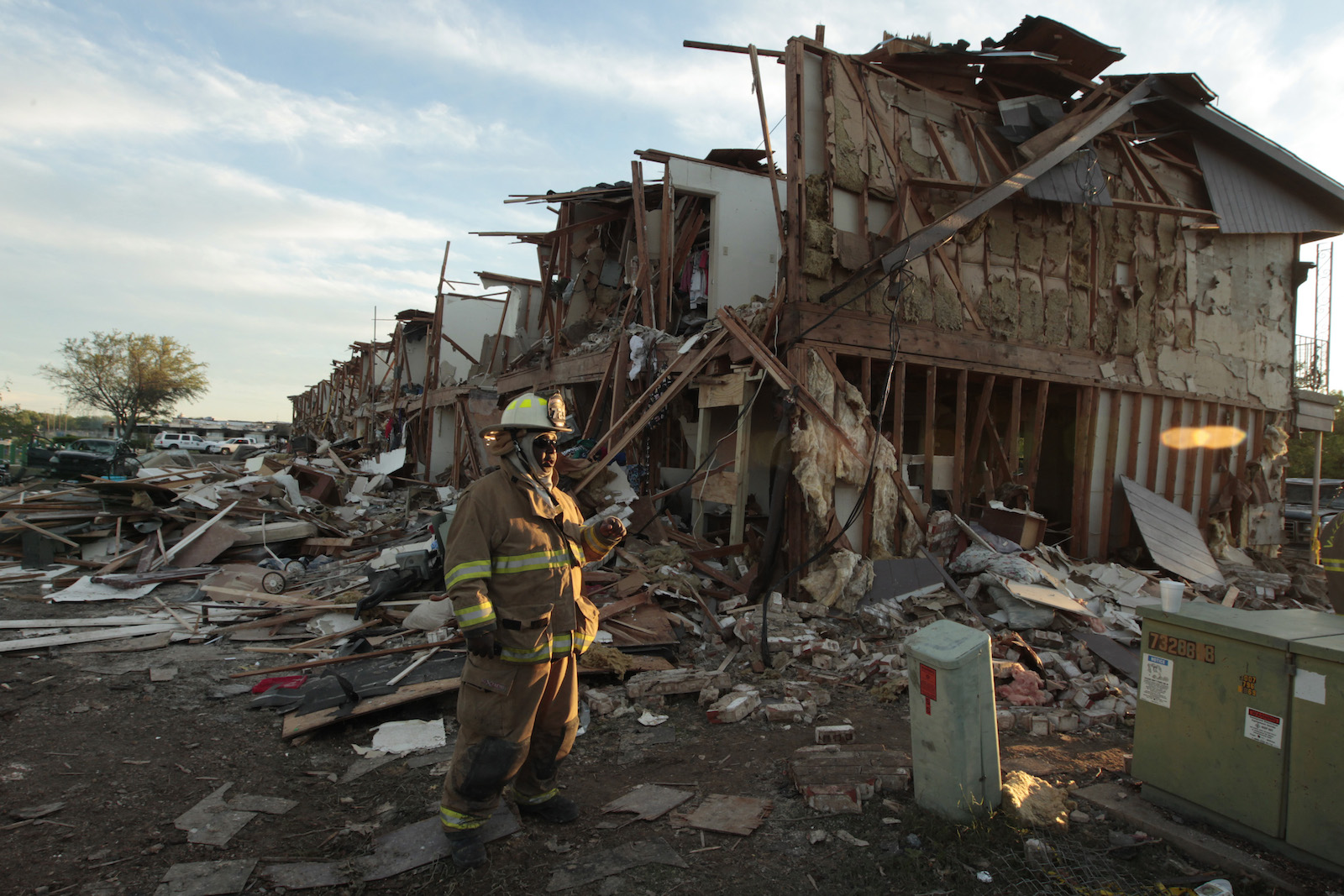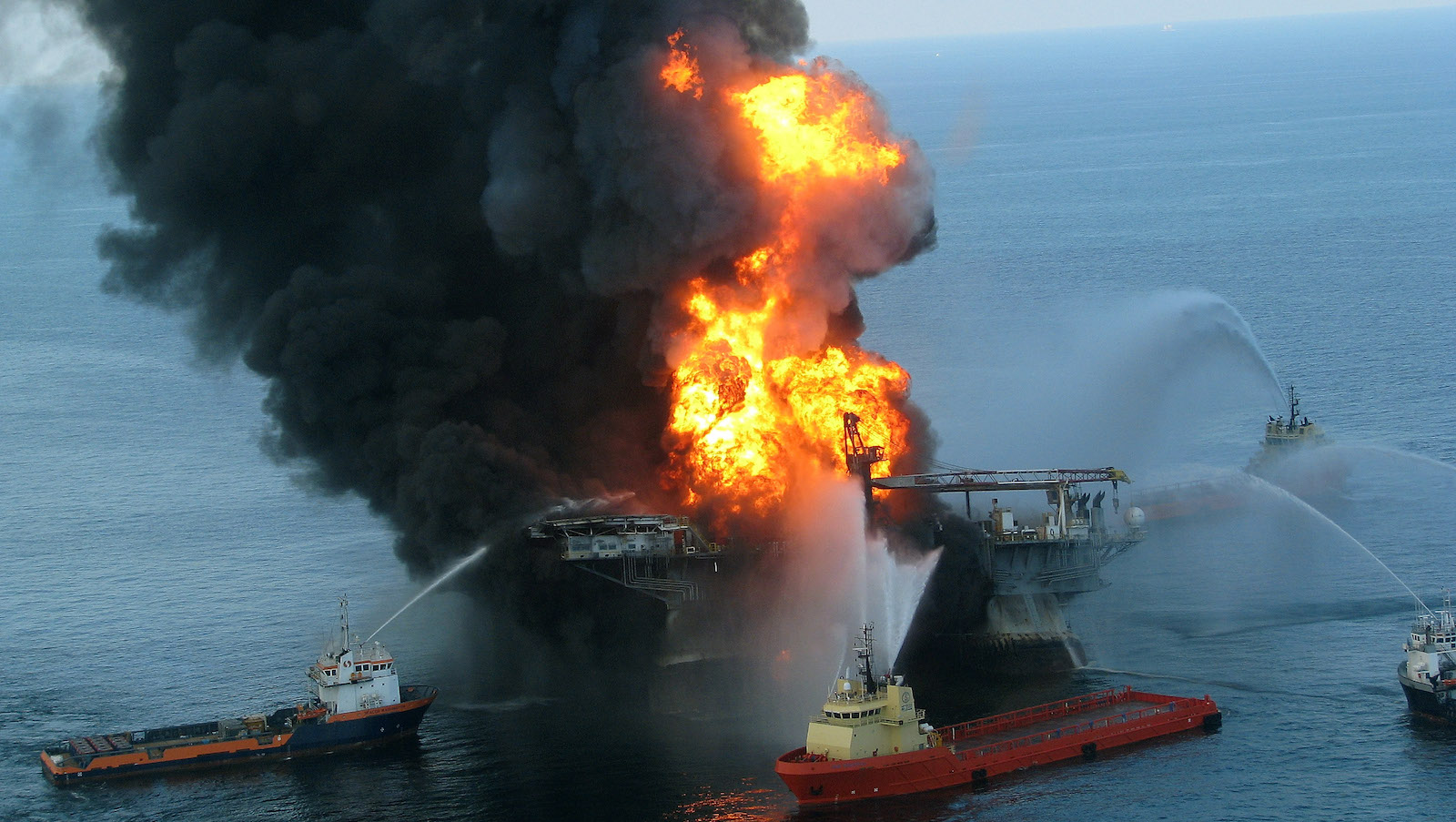This story was originally published by Reveal and is reproduced here as part of the Climate Desk collaboration.
On a warm morning in April, workers at a Wisconsin oil refinery were conducting a routine shutdown for maintenance. Suddenly, a gasoline cracking unit exploded, and the workers watched in horror as a huge fireball ripped through the plant. They ran for their lives, barely escaping the blast.
Debris from the explosion ruptured a tank, which spilled more than half a million gallons of hot asphalt which burst into flames and burned for nine hours. Black smoke spread over the port town of Superior. Eleven workers were injured, and about 40,000 people were evacuated from nearby homes and schools.
Within 24 hours of the explosion at the Husky Energy Inc. refinery, a small team of federal investigators arrived. Their mission, Superior Mayor Jim Paine reassured residents, was to “find out what happened and how we prevent it in the future.”

Workers evacuate from an explosion and fire at the Husky Energy oil refinery in Superior, Wisconsin on April 26, 2018. Jules Ameel / AFP / Getty Images
Earlier this month, after a three-month probe, the investigators from the U.S. Chemical Safety and Hazard Investigation Board concluded that a faulty valve at the plant caused the explosion. The board plans to issue recommendations that aim to prevent such an accident from happening again at a refinery.
But despite the warm welcome in Superior — and wide recognition of its expertise in chemical plant disasters — this small, independent federal agency is teetering on the brink of elimination.
The Trump administration has twice in its budgets attempted to shut down the Chemical Safety Board; so far, Congress has rejected these attempts. For the 2019 fiscal year, both the House and Senate have proposed restoring full funding.
But the assaults appear to be taking a toll. Hostility from the Trump administration and disarray from its efforts to eliminate the agency follow years of leadership turmoil and high turnover that started during the Obama administration. In 2015, its chair, who was embroiled in a congressional investigation into poor management, resigned under pressure — yet leadership problems remain.
Combined, these problems threaten to cripple the agency’s investigations of chemical plant disasters, according to interviews and reports obtained by Reveal from The Center for Investigative Reporting. A report from the U.S. EPA’s inspector general says the turmoil “if not addressed, may seriously impede the agency’s ability to achieve its mission efficiently and effectively.”
The Trump administration argues that the Chemical Safety Board duplicates the work of other federal agencies. Administration budget documents also cite unspecified complaints from industry and other federal agencies about the board’s recommendations for new regulations of the chemical industry.
Health and safety advocates and labor unions say the board is essential because aging oil and chemical facilities have had some of the deadliest and costliest industrial accidents in the past two decades.
More than 12,000 plants store or handle toxic or flammable chemicals in the United States. Under worst-case scenarios for more than 2,500 of these facilities, between 10,000 and 1 million people could be harmed, according to a 2012 Congressional Research Service report. An estimated 4.6 million children at nearly 10,000 schools are within one mile of a plant that handles hazardous chemicals, according to the Center for Effective Government.
Local officials, including emergency responders, often have little information about the chemicals and safety conditions at the plants in their communities. The chemical industry keeps much of this information under wraps, invoking national security and a need to protect confidential business information.
“Millions of people live and work in the shadow of high-risk chemical plants that store and use highly hazardous chemicals,” said Jordan Barab, a former board investigator who now blogs about worker safety.
Little-known federal agency

A Valley Mills Fire Department personnel walks among the remains of an apartment complex next to the fertilizer plant that exploded in 2013 in West, Texas.
Over its 20-year history, the Chemical Safety Board has investigated more than 150 explosions, fires, and spills at chemical plants and oil refineries.
Included are the 2012 Chevron refinery fire in Richmond, California, which drove about 15,000 people to seek medical care, and the 2013 West Fertilizer Co. explosion in Texas, where 15 people, including 12 emergency responders, died and 350 homes were damaged or destroyed.
Similar to the National Transportation Safety Board, which probes airplane, ship, and railroad accidents, the Chemical Safety Board has no regulatory authority and does not issue fines or prosecute companies. But its findings often point to problems that other agencies may act upon: It has issued 815 recommendations designed to prevent tragedies at oil and chemical plants.
Established by Congress in the wake of two chemical plant explosions in Texas that killed or injured more than 350 workers, the board has a staff of 35 and a budget of $11 million a year — minuscule compared with other federal agencies. For the next fiscal year, the House has proposed $12 million in funding, while the Senate has proposed $11 million.
Mike Wright, director of health, safety, and environment for the United Steelworkers, has called the board “one of the best bargains in Washington. If it has prevented even one accident, it has saved far more money than its budget over its entire history.”
The Trump administration has justified its proposal to eliminate the agency by saying other agencies, such as the Occupational Safety and Health Administration and the EPA, already do similar investigative work.
“Congress intended CSB to be an investigative arm that is wholly independent of the rulemaking, inspection, and enforcement authorities of its partner agencies,” according to Trump administration budget documents. “While CSB has done some useful work on its investigations, its overlap with other agency investigative authorities has often generated friction. The previous management sought to focus CSB’s recommendations on the need for greater regulation of industry, which frustrated both regulators and industry.”
There apparently was friction between two federal agencies during the investigation of the West Fertilizer disaster in Texas. The Bureau of Alcohol, Tobacco, Firearms and Explosives concluded that the cause was arson, while the Chemical Safety Board reported that unsafe storage practices for combustible materials contributed to the explosion and a lack of sprinklers spread the flames. The bureau kept Chemical Safety Board investigators away from the site for four weeks, which hampered their ability to investigate the explosion, according to a board report.
The White House did not disclose any evidence that industry groups or companies have complained about the board’s investigations or recommendations.
The American Chemistry Council, which represents chemical companies, told Reveal in a statement that its members “find considerable value in the CSB’s work — especially the reports and materials generated by the Board as part of its investigations.” The investigations “raise industry awareness to potential problems” and “have benefitted ACC, its members and the public.” The industry group, however, declined to answer questions.
But former board Chair Rafael Moure-Eraso, who resigned under pressure in 2015, blames his ouster on retaliation by some Republican members of Congress for his agency’s aggressive investigations of oil company accidents, including the 2010 Deepwater Horizon spill in the Gulf of Mexico; the 2010 Tesoro refinery accident in Anacortes, Washington; and the 2012 Chevron refinery fire in California.
In those three investigations, the board made recommendations “that were opposed by industry groups … and their friendly congressmen in the U.S. House of Representatives,” Moure-Eraso said. The overarching recommendation was that federal regulations should require refineries and offshore oil platforms to continually meet higher safety standards and reduce risk.
Moure-Eraso said industry groups welcome investigations because they improve safety for their workers and neighbors. But, he added, the groups oppose some of the board’s recommendations.
“When changes on improving protections require regulation, the support abruptly ends,” he said.
For example, after the Texas fertilizer plant explosion, the Obama administration enacted safety measures requiring more detailed public reporting of chemical hazards and improved safety training. But under President Donald Trump, former EPA Administrator Scott Pruitt moved to rescind most of the new rules, saying they would cost the industry too much — an estimated $88 million a year — and could make public information about chemical plants that would be useful to terrorists.
Moure-Eraso said the board’s highly technical investigations are not duplicated by federal regulatory agencies, which “obviously have failed to prevent some major chemical accidents.”
The EPA inspector general’s office under the Trump administration appears to agree. In a June report, the office said the board’s work complements other agencies’ work because “the root causes of an incident go beyond whether there was a violation of a regulation.”
Adam Carlesco, staff counsel for the nonprofit Public Employees for Environmental Responsibility, which represents government employees, said the chemical industry has stalled efforts to improve reporting of chemical plant accidents.
His group has sued to enforce a part of the board’s statutory authority that says it must compel companies to report plant accidents directly to the board. When the board tried to do this in 2009, industry groups called it burdensome. The pushback eventually led the board to drop the effort.
‘Agency in disarray’
During the Obama administration, two House committees investigated charges that the board under Moure-Eraso had an abusive and hostile work environment and conspired to punish agency whistleblowers. No details about the whistleblowers were released publicly.
Also, the EPA’s inspector general criticized the number and pace of investigations. A 2014 report by the two House committees called it an “agency in disarray.”
The turmoil continues. Since January, the board has lost seven of its 18 investigators. In June, its chair since 2015, Vanessa Sutherland, resigned and took a vice presidency job with a railroad company. And the EPA inspector general’s June report identified more mismanagement problems, including evidence that an unidentified board member improperly shared information with a labor union representative.
The inspector general’s office reported “negative impact from the President’s continued proposal to eliminate the agency.”
“This budget uncertainty impedes the CSB’s ability to attract, hire and retain staff,” according to the report, which added that the board “should continue to work with Congress toward achieving funding needs wherever possible.”
Earlier this month, U.S. Representatives Trey Gowdy, a Republican from South Carolina and the chair of the House Committee on Oversight and Government Reform, and Greg Gianforte, a Republican from Montana and chair of the Interior, Energy and Environment Subcommittee, wrote the White House asking that Trump nominate a new chair because the vacancy “could plunge the agency into further chaos.”
The board members and chair are appointed by the president and confirmed by the Senate.
“Recent reports indicate mismanagement and improper conduct continue to undermine the CSB’s mission,” the representatives wrote.
Living in fear in Superior
Debates about budgets and board leadership are not much of a balm for people who live with oil and chemical plants in their communities.
Residents of the Twin Ports area — the cities of Superior, population 27,000, and Duluth, Minnesota — still live in fear of the Husky Energy plant after the April accident.
Those who live near the refinery said the explosion was so powerful that they could feel the detonation. They now understand a harsh reality shared by millions of Americans: An accident at a chemical plant or refinery in their community could level their homes or injure them with toxic gases or smoke.
“I watched this … scary thing happen off my back porch,” Superior resident Renee Goodrich said at a City Council meeting a few days after the accident.
“Looking back, the normal pace of that day was terrifying,” said resident Gabriela Vo. “Were the citizens of Pompeii just going about their daily lives when the fateful volcano erupted? The smoke alone was enough to raise health concerns, let alone the possibility of the town blowing up.”
The black smoke posed some health risks due to high concentrations of fine particles, but after it cleared, monitoring by company and county officials showed no air pollutants violated health standards.
Husky pledged cooperation and transparency with officials, and the Chemical Safety Board investigators said the company granted them full access to its plant and records. The company declined to answer questions from Reveal, citing the ongoing investigation.
The investigators concluded that a worn-out valve in a fluid catalytic cracking unit — equipment used to refine gasoline — allowed air to contact flammable chemicals, triggering the explosion. The board now is developing its recommendations on how to avoid such accidents.
It could have been a catastrophe: The board’s investigators reported that debris flew 200 feet into an asphalt tank. A storage tank filled with highly toxic hydrogen fluoride sits in the same area, just 150 feet away from the cracking unit that exploded. It was undamaged. If it had ruptured, the fumes could have caused severe injuries or deaths.
The company said the plant has a system of safeguards that would have prevented release of the gas, which is used to make high-octane gasoline, even if the tank had been punctured.
“The [hydrogen fluoride] storage tank is designed with multiple protection levels including a dedicated deluge system that douses the tank with a water curtain to keep it cooled and mitigate potential releases,” the company said in a statement.
But many locals — including Pat Farrell, a University of Minnesota Duluth soil scientist who is pushing for safety changes — think the town got lucky.
“One piece of shrapnel would have been all that was necessary for a major disaster, the scale of which the Twin Ports here have never seen,” Farrell said.




